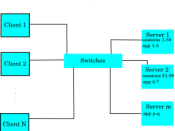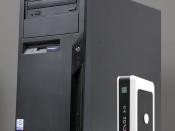Report on Client Preference
There are two main types of workstation or "clients" in use on a Network in Business today. These are Thick Clients and Thin Clients. The main difference between thick and thin clients are that thin clients only house the bare essential components to function on board. This will be looked at in more depth at a later stage. Thick clients however are very robust systems such as a standalone PC that you or I might have at home or in an office. More and more Businesses and, for that matter, schools and educational establishments in general are changing from thick to thin clients these days. The reasons for this could are varied and some of the features and benefits given below may help to explain this: -
Thin Clients
ÃÂHave no hard Drive
ÃÂMemory or any other expensive components
ÃÂReduced the risk of equipment theft
ÃÂReduced the risk of tampering
ÃÂAlmost no risk of Virus infection
ÃÂNo on board processing power
ÃÂApplications all run from server
ÃÂNarrower bandwidth required
ÃÂ
Thick Clients
ÃÂOn board Hard Drive
ÃÂOwn Memory
ÃÂRequire regular hardware updates
ÃÂRisk of Virus Infection
ÃÂOwn storage space
ÃÂOwn applications
Judged on the above statistics it would look as though the thin client option would be a lot more sensible and financially viable but this is not always the case.
With thin clients all the processing has to be done by a centralised server, therefore the processing power on the server has to be very substantial depending on the usage and of course size of the Network. The server would also have to be updated with anti-Virus software on a regular basis, constantly in fact, as the security of many hundreds of clients could depend on it. This is also the case for Backup...



Thin Clients vs. Thick Clients
A good job of presenting the 'versus' in this essay between the two types of clients. Never heard of the two before.
4 out of 4 people found this comment useful.